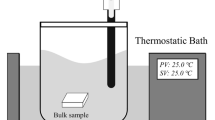Abstract
Secondary ion mass spectrometry has been used to measure the silicon isotope ratio as a function of depth in feldspars after their interaction with dilute acid solutions. The reaction of feldspars with aqueous solutions implies the formation of relatively thick K, Na and Al depleted surface layers, especially when the dissolution experiments are conducted in the presence of silica powder. The latter is used to lower the silicon concentration gradient at the solid-solution interface. This generates an uncertainty in the interpretation of the results: the depleted surface layer may have been formed by leaching of the above-mentioned elements from the solid, or by precipitation of silica from the solution. Measurements using isotopically enriched silica powder (30SiO2) were therefore performed in the hope that they would solve the uncertainty. The measured silicon isotope ratio at the surface of the mineral appears to be different from its normal terrestrial value and from the enriched powder value, having a value somewhere in between which decreases towards its normal value as a function of depth. In addition the silicon isotope ratio of the solution, which was measured using thermal ionization mass spectrometry, shows an altered value compared with the enriched silica powder. The results of both analyses therefore indicate an exchange in silicon between solid and solution and suggest the combination of two or more mechanisms during dissolution.
Similar content being viewed by others
References
T. Claesson, B. Ronge,Proc. Int. Symp. on Water-Rock Interaction (WRI-4), Misasa, Japan, 1983, 90.
D. A. Goossens,Experimental Study of Water Rock Interaction Using SIMS, Dissertation, University of Antwerp, Belgium, 1990.
D. A. Goossens, J. G. Philippaerts, R. Gijbels, A. P. Pijpers, G. Van Tendeloo, E. Althaus, in:Water-Rock Interaction VI (D. L. Miles, ed.), Balkema, Rotterdam 1989, p. 271
D. A. Gossens, A. P. Pijpers, J. G. Philippaerts, E. Althaus, R. Gijbels, in:European Geothermal Update (K. Louwrier, E. Staroste, J. P. Garnish, V. Karkoulias, eds.), Kluwer, Dordrecht, p. 395.
D. A. Goossens, A. Adriaens, A. P. Pijipers, J. G. Philippaerts, E. Althaus, G. Van Tendeloo, R. Gijbels,Geochim. Cosmochim. Acta submitted.
M. Rener, A. Lamberty, P. De Biévre,Analusis 1992,20, 229.
B. J. Giletti, M. P. Semet, R. A. Yund,Geochim. Cosmochim. Acta 1978,42, 45.
A. Hofmann, B. Giletti, J. Hinthorne, C. Andersen, D. Comaford,Earth Planet. Sci. Lett. 1974,24, 48.
L. S. Clesceri, A. E. Greenberg, R. R. Trussell (eds.),Standard Methods for the Examination of Water and Waste Water, 17th Ed., American Public Health Association, Washington, DC, 1989.
A. Adriaens, W. R. Kelly, F. C. Adams,Anal. Chem. 1993,65, 660.
Author information
Authors and Affiliations
Rights and permissions
About this article
Cite this article
Adriaens, A., Van't dack, L., Adams, F. et al. Mass spectrometric study of the dissolution behaviour of sanidine. Mikrochim Acta 120, 139–147 (1995). https://doi.org/10.1007/BF01244427
Received:
Revised:
Issue Date:
DOI: https://doi.org/10.1007/BF01244427




